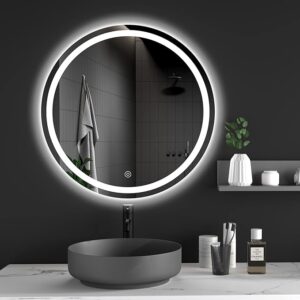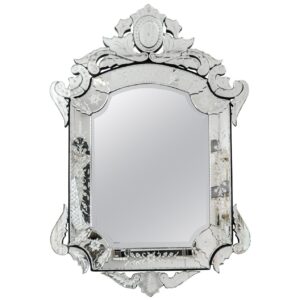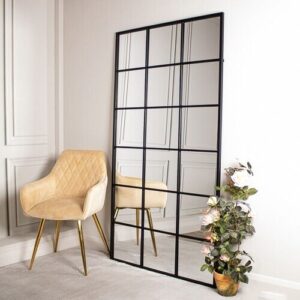Mirrors are not merely functional objects; they are powerful tools in interior design, capable of transforming spaces, enhancing lighting, and adding depth to any room. From their ancient origins to modern-day applications, mirrors have held a prominent place in human culture and design. Let’s delve into the fascinating world of mirrors, exploring their history, types, uses in interior design, and considerations when incorporating them into your space.
A Brief History:
The use of mirrors dates back thousands of years. Ancient civilizations, such as the Egyptians, Greeks, and Romans, crafted rudimentary mirrors from polished metal, obsidian, or highly polished stones. These early mirrors were primarily used for personal grooming and as symbols of wealth and status.
The invention of glass mirrors as we know them today can be attributed to the Venetians in the 13th century. Venice became a centre for mirror production, utilizing a combination of glassblowing and metal backing techniques to create reflective surfaces. This innovation paved the way for the mass production of mirrors, making them more accessible to people across various social classes.
Why Mirrors Are Used in Interior Design:
Mirrors serve multiple purposes in interior design, making them indispensable elements for designers and homeowners alike:
Enhancing Lighting: Mirrors can amplify natural light by reflecting it throughout the room, making spaces appear brighter and more inviting. Strategically placing mirrors opposite windows or light sources maximizes their light-reflecting properties.
Creating Illusions of Space: In smaller rooms or areas with limited natural light, mirrors can visually expand space and make it feel more open and airy. Placing mirrors on walls or ceilings can give the impression of depth and height.
Adding Dimension and Depth: Mirrors can visually enlarge rooms by creating reflections that extend the space beyond its physical boundaries. They also add depth to interiors by reflecting architectural elements, artwork, or furniture.
Decorative Accents: Beyond their functional benefits, mirrors serve as decorative accents that contribute to the overall aesthetic of a room. They come in a myriad of styles, from sleek and modern to ornate and vintage, allowing for endless design possibilities.
Types and Styles of Mirrors:
Mirrors come in a plethora of shapes, sizes, and styles to suit diverse design preferences and functional needs. Some common types include:

Wall Mirrors: These are versatile and can serve as focal points or decorative accents in any room. Wall mirrors come in various shapes, such as rectangular, round, oval, and geometric.

Floor Mirrors: Ideal for dressing rooms and bedrooms, floor mirrors provide full-length reflections and can visually expand space.

Vanity Mirrors: Typically found in bathrooms and dressing areas, vanity mirrors come in various styles, including pedestal, framed, and magnifying mirrors.

Decorative Mirrors: These mirrors are designed with intricate frames, bevelled edges, or unique shapes to add visual interest and enhance the aesthetic appeal of a space.

Mirrored Furniture: Furniture pieces featuring mirrored surfaces, such as cabinets, dressers, and coffee tables, can create a sense of luxury and glamour while also reflecting light and space.

Overmantel Mirrors: Often found above fireplaces, overmantel mirrors are large and ornate, serving as striking focal points in traditional or formal living spaces.

Venetian Mirrors: Characterized by their elaborate glasswork and etching, Venetian mirrors originated in Venice during the 16th century. They feature intricate designs and delicate craftsmanship, adding a touch of old-world charm to interiors.

Antique Mirrors: Antique mirrors add character and history to a room, showcasing craftsmanship from bygone eras. They come in various styles, including Baroque, Rococo, and Art Deco, each reflecting the design aesthetics of its respective time period.

Frameless Mirrors: Sleek and minimalist, frameless mirrors offer a contemporary look that seamlessly integrates into modern interiors. They are popular choices for bathrooms, entryways, and minimalist living spaces.

Bevelled Mirrors: Bevelled mirrors feature edges that are cut and polished at an angle, creating a framed effect without the need for a traditional frame. This subtle detailing adds dimension and sophistication to the mirror’s appearance.

Tinted Mirrors: Tinted mirrors come in various hues, such as bronze, smoke, or champagne, adding a subtle tint to reflections. They can create a warm, inviting atmosphere or lend a touch of vintage glamour to a space.

Furniture Mirrors: Mirrors can be integrated into furniture pieces such as wardrobes, armoires, and dressers, providing both functionality and style. Furniture mirrors often feature decorative frames or intricate detailing, enhancing their aesthetic appeal.

Mirrored Tiles and Panels: Mirrored tiles and panels are versatile design elements that can be used to create feature walls, backsplashes, or decorative accents. They add depth and luminosity to interiors while also serving practical purposes in kitchens, bathrooms, and living areas.
The Use of Mirrored Furniture:
Mirrored furniture has surged in popularity in recent years, offering a glamorous and sophisticated aesthetic to interiors. Here’s why mirrored furniture is a favourite choice for many homeowners and designers:
Elegance and Glamour: Mirrored furniture exudes elegance and adds a touch of luxury to any room. Its reflective surfaces create a sense of opulence while also enhancing the overall ambiance.
Space Enhancement: Similar to mirrors, mirrored furniture can visually expand space and make rooms feel larger and more spacious. Its reflective qualities bounce light around the room, brightening dark corners and creating a sense of openness.
Versatility and Adaptability: Mirrored furniture blends seamlessly with various design styles, from contemporary and modern to traditional and eclectic. It can serve as a statement piece or complement existing décor, offering versatility in styling options.
Dos and Don’ts When Purchasing Mirrors:
When selecting mirrors for your home, consider the following dos and don’ts to ensure they complement your space effectively:
Do:
Consider the Room’s Layout and Purpose: Choose mirrors that harmonize with the room’s style and function. For instance, a large wall mirror in the living room can create a focal point, while a vanity mirror in the bathroom should prioritize functionality.
Experiment with Placement: Explore different placement options to maximize the impact of mirrors in your space. Experiment with hanging mirrors at varying heights and angles to achieve the desired visual effect.
Mix and Match Styles: Don’t be afraid to mix and match mirror styles to create contrast and visual interest. Combining modern and vintage mirrors or incorporating mirrors with diverse frame designs can add depth to your interior décor.
Don’t:
Overdo It: Avoid cluttering a room with too many mirrors, as this can overwhelm the space and diminish their impact. Opt for a balanced approach by strategically placing mirrors where they can enhance lighting and aesthetics without overpowering other elements.
Ignore Scale and Proportion: Consider the size and scale of the mirrors relative to the surrounding furniture and architectural features. Oversized mirrors in small rooms or undersized mirrors in large spaces can disrupt visual harmony.
Forget about Maintenance: Keep in mind the maintenance requirements of mirrors, especially those with intricate frames or decorative details. Regular cleaning and care will preserve their appearance and reflective properties over time.
Mirrors are indispensable elements in interior design, offering both functional and aesthetic benefits. From their ancient origins to modern-day applications, mirrors continue to captivate our imagination and enhance the beauty of our living spaces. Whether used as decorative accents, space enhancers, or focal points, mirrors have the power to transform any room into a reflective masterpiece. So, the next time you’re designing or redecorating your home, don’t forget to mirror, mirror on the wall!




